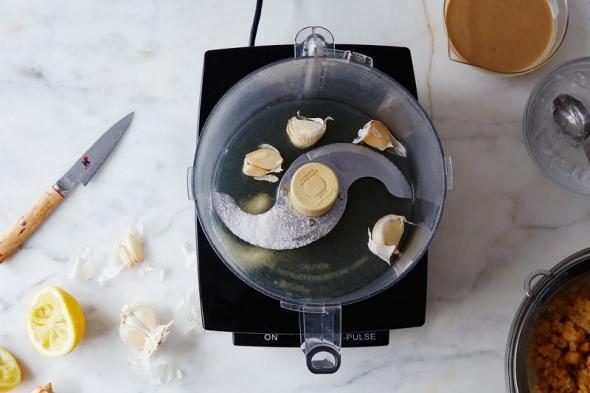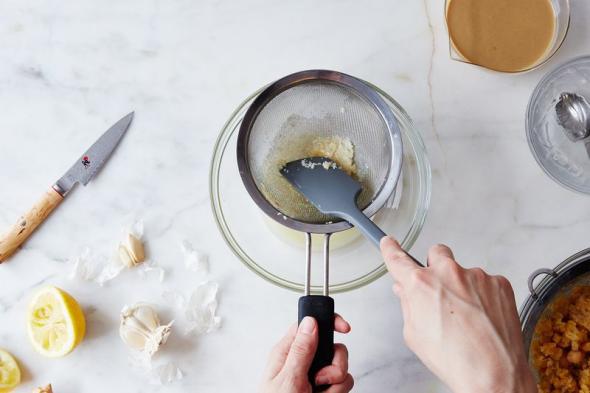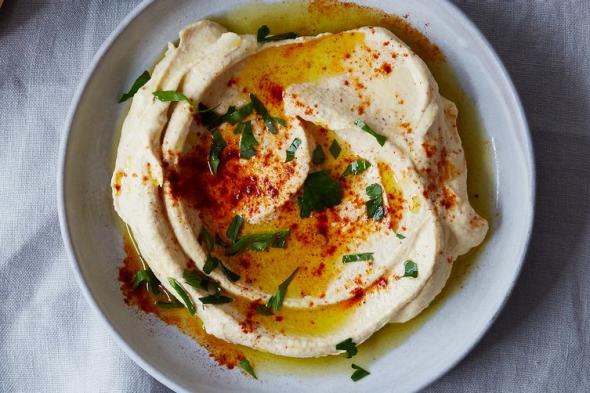This post originally appeared on Food52.
There’s been a whole lot of talk about Zahav’s hummus lately—ascribing to it the texture of buttercream, the phrase revelatory heights, and being both the creamiest and the dreamiest. Bon Appétit named it their 2015 dish of the year. In Phyllis Grant’s recent Piglet judgement, she wrote that the first chapter alone, with its seven types of hummus, should win a James Beard Award.
But in all of these heaps of accolades, no one has said boo about the craziest and most genius part. Wait till you see it!
The genius of this hummus is credited to all sorts of smart maneuvers in Chef Michael Solomonov’s process: soaking the chickpeas in baking soda to lower the pH and soften their skins, his respect for the finest tahini to drive the flavor (he likes Soom Foods), intentionally overcooking the chickpeas until they’re just shy of total mush, then whipping them longer than you think you should, till the hummus practically floats.
All of these details make the hummus what it is: an unearthly cloud, with a haunting, smoky, nutty pulse. “Making Hummus Tehina is one of the hardest things we do at Zahav,” Solomonov wrote to me. “Without just the right technique, it just doesn’t work.”
But there’s one more fascinating step that I’m stunned no one has zeroed in on, that has perhaps the biggest effect on the hummus’ nuanced flavor. It was so strange that I had to re-read it a few times. Break up the head of garlic with your hands, letting the unpeeled cloves fall into a blender. Come again?

Bobbi Lin
Yes, you drop whole unpeeled cloves of garlic, papery skins and all, into the blender (or food processor), then mulch it all up with lemon juice and salt. It’s an unsettling mixture to think about, filled with inedible debris—until you learn that it’s just steeping for 10 minutes, then all getting strained away.

Bobbi Lin
What this means, aside from the fact that you don’t have to peel anything, is that you’re not adding mashed garlic—fiery, unhinged, very perishable garlic—directly into the hummus, which would usually mean that it would taste precipitously worse and less fresh, the longer it sits in the fridge. (I’d give your average hummus 3 days, tops.)
You’re instead adding garlic-infused lemon juice, which makes for a much more gently garlicky, and therefore more fridge-stable, hummus. Solomonov would probably want me to point out, as he writes in Zahav, “Please note that great hummus is never refrigerated,” but we can’t all be a hummusiya (though if you want to visit one, his New York City outpost of Dizengoff is opening in Chelsea Market next week).
Just eat whatever you can, then let any lingering in the fridge come down to room temp and it will be pretty darn great. (Also creamy, dreamy, revelatory, buttercream-esque, and so forth.)

Bobbi Lin
Zahav’s Hummus Tehina
Makes about 4 cups
1 cup dried chickpeas
2 teaspoons baking soda, divided
4 garlic cloves, unpeeled
⅓ cup (or more) fresh lemon juice
1 teaspoon kosher salt, plus more
2/3 cup excellent quality tahini (a.k.a. tehina—Chef Michael Solomonov loves Soom Foods, available on Amazon)
¼ teaspoon (or more) ground cumin
Olive oil, for serving
Chopped parsley and paprika, for serving (optional)
See the full recipe at Food52.
More from Food52:
A Cheaper Way to Make Pesto & 8 Weeknight Meals to Use It In
5 Tips Obvious to Baking Experts, Surprising to the Rest of Us
In Defense of Airport Bars
Roast Pasta Before Cooking it. Really!
8 Chicken Recipes That Come with Their Own Sides
Lemon Cupcakes They’ll Never Know Are Vegan
